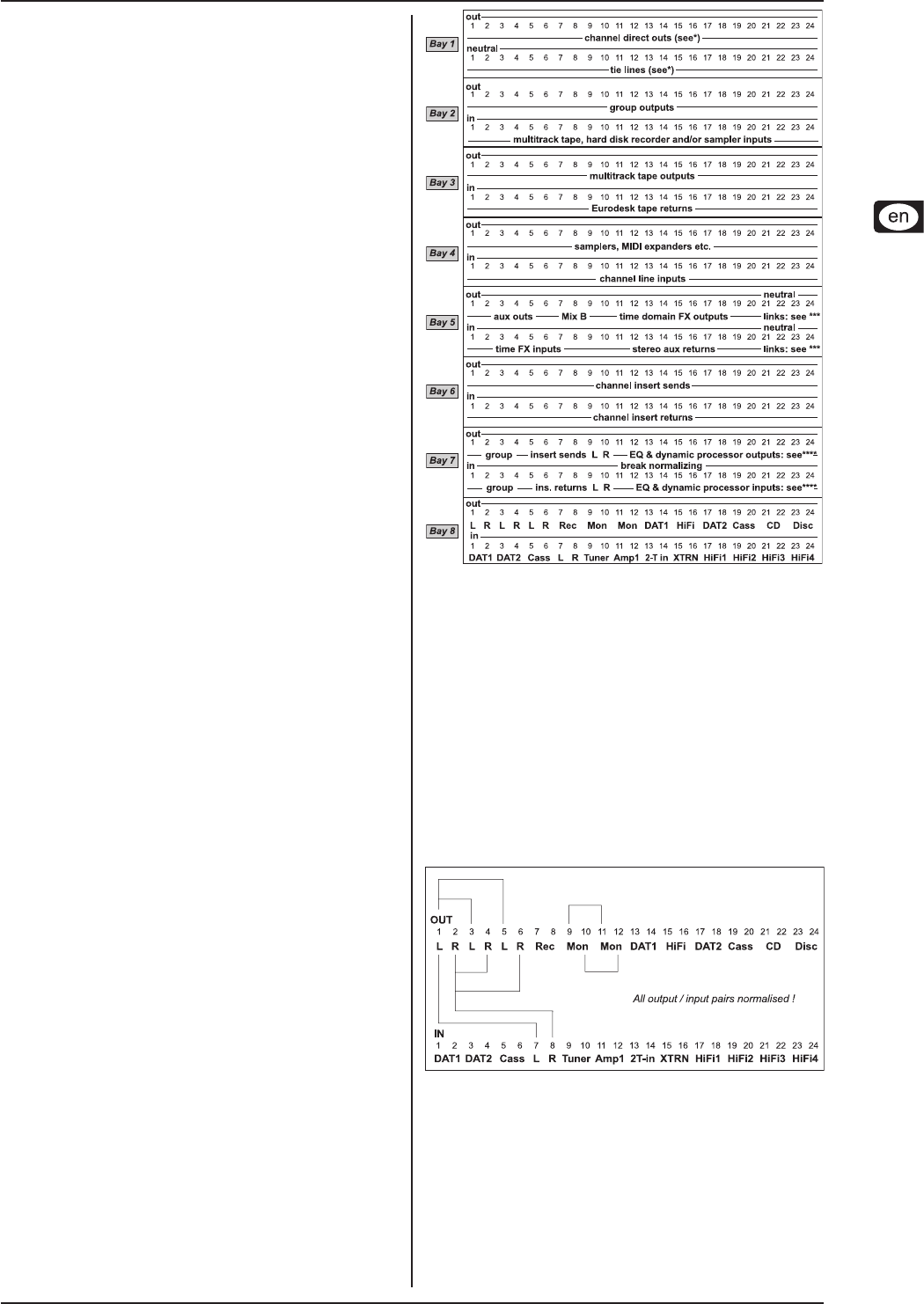
EURODESK SX4882
The patcheld 15
The patcheld8.
Nomenclature clarication:
FIELD= entire patching area =
BAY= a unit of 48 jack sockets arranged as 24 outs over 24 =
ins
If you really want to make the most of your home studio, invest in
a patcheld. We know that you will often put off doing a complex
patch if there is no patcheld:
because it’s so much bother and1)
in case you inadvertently damage or pull out a lead.2)
The normalized bay8.1
Most decent jackbays offer two rows of 24 normalized jacks in a 1
U of rack space. Lucky you’ve got a 24/48 channel desk, eh? The
term normalized refers to the fact that the top row (outputs) are
internally connected to the bottom row (inputs), unless you plug
something into an input socket. Plugging into the output socket of
a normalized insert pair does not break the internal connection,
but it does provide an alternative direct output. Where normalizing
is not wanted on a patchbay (there are a few cases!) it is possible
to remove it by cutting certain PCB tracks. Refer to the patchbay
instructions for how to do this.
The patcheld8.2
If you want to do the only decent thing and construct a patch-
eld for your studio, here’s how to do it. Note that we have laid
it out in order that a minimum number of cables are likely to be
needed. We have also completely left out the microphone inputs.
Unlike everything else, these operate at a level several orders of
magnitude lower than line (+4 dBu or -10 dBV). It is best to plug
microphones directly into the EURODESK SX4882, or via special
XLR-type wall boxes connected to the EURODESK microphone
inputs by a good quality balanced (2-core + screen) multicore.
(See also section 12 “(Un)balanced lines”.)
*
Break the normalizing on this bay.
**
Tie lines: usually, in a MIDI setup, racks and keyboards etc. are
scattered around the control room. Plugging these directly into the
front of the patchbay would result in Spaghetti Junction. Instead,
it is better to connect TIE LINE jacks to wall boxes strategically
positioned near to where MIDI hardware congregates.
***
It’s always good to have a few 4-way links around for splitting
signals up to 3 ways (one in, three out). E.g. one tape track has four
different instruments on it. Patch the DIRECT out of its CHANNEL
into a 4-way split, returning to a further 3 channels via LINE INPUT.
Set up each of the paralleled 4 channels for one instrument, and
use mutes (preferably MIDI controlled) to mute the 3 unwanted
channels at any one time).
Break the NORMALIZING LINKS on positions 21 - 24. +
Note also that the MIX-B outputs are adjacent to the
aux sends. This is because one of the two functions of
MIX-B (source switches set to CHANNEL) is to provide
an extra stereo aux send.
You can treat MIX-B as two mono sends using GAIN for +
level and PAN for blending. Setting pan to the center
will give a 50/50 ratio of the “aux 7” and “aux 8” effect,
hard left 100% “aux 7”, etc.
****
Break NORMALIZING LINKS here. If you’ve got more than 5
or 6 stereo dynamics/EQ processors, you might spill over onto
another dedicated bay, or alternatively have to nd some suit-
able extra space somewhere else in the patcheld. Remember,
most dynamics processors also have sidechain/KEY inputs, and
therefore require 3 holes per channel.
Enhancers are usually applied across INSERTS like com- +
pression and EQ etc., but most BEHRINGER enhancers
have a SOLO mode, in which they can be addressed via
an aux send and blended back into the main mix like
any other reverb.
Example of patchbay congurationsFig. 8.3:
Bay 8:
L7 & R8 equals the L/R recording input to the 2-tracks. On Bay
8 we have hard-wired these to recording outputs 1 to 6 in order
to drive all recorders simultaneously. Copying from any 2-track
source to all recorders may be done by patching the source
outputs into L7 and R8.
We have assumed you have a HiFi amp available to enable a
variety of secondary sources to be condensed into the XTRN (ex-
ternal) input for easy monitoring selection via the HiFi amp’s input
selector switch, if you want to record from any of these sources,
best patch direct from the individual outputs (17 to 22) rather than
the HiFi amp mix (15 and 16) for the cleanest result. (The exception
being vinyl, which will need to use the HiFi amp’s RIAA pre-amp
to present the mixer with a at response signal).
Wiring for bay 8 (for advanced wir-Fig. 8.4:
ing scheme refer to section 11)
Looming problems8.3
Loom wiring is an art in itself, and it is worth taking time out to get
it right. First, it is important to avoid earth loops. (A looped wire
acts as an arial, picking up electromagnetic radiation.) Think of
a tree: Every part of that tree is connected to every other part,
but only by one route. That’s how the total earth picture for your
entire studio should look. Don’t take the earth off your power
cable plug to reduce audible 50 Hz mains hum (or its harmonics).


















